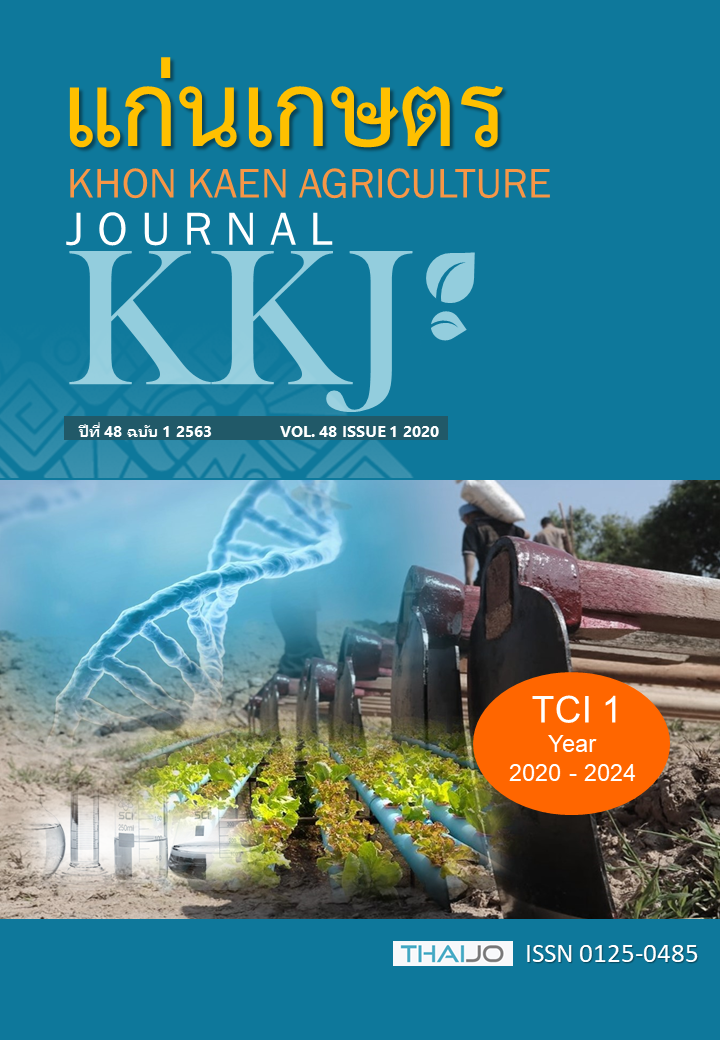การแสดงออกของยีน TPS1 และTPS2 และค่าพลังงานศักย์ของน้ำในใบในอ้อยสองพันธุ์ภายใต้สภาพขาดน้ำ
Main Article Content
บทคัดย่อ
สภาวะขาดน้ำจัดเป็นปัจจัยสำคัญที่ส่งผลให้การเจริญเติบโตและผลผลิตในพืชลดลง กลไกหนึ่งที่พืชใช้เพื่อปรับตัวต่อสภาพขาดน้ำคือการสะสมสาร osmoprotectant เพื่อรักษาสมดุลของน้ำภายในเซลล์ ยีน trehalose-6-phosphate synthase (TPS) เป็นยีนที่เกี่ยวข้องกับการสังเคราะห์น้ำตาลทรีฮาโลส ซึ่งเป็นหนึ่งในสารที่ช่วยให้พืชทนต่อสภาพเครียดจากสิ่งแวดล้อมได้ เพื่อศึกษาการตอบสนองทางสรีรวิทยาและการแสดงออกของยีน TPS1 และ TPS2 ในอ้อยภายใต้สภาพขาดน้ำ ได้จำลองสภาพเครียดจากการขาดน้ำให้กับอ้อยพันธุ์กำแพงแสน 94-13 และพันธุ์กำแพงแสน 01-11-6 ในอาหารเหลวสูตร MS ที่เติม 16% polyethylene glycol (PEG) 6000 เป็นระยะเวลา 24, 48, 72, 96 และ 120 ชั่วโมง พบว่าอ้อยทั้งสองพันธุ์มีค่าพลังงานศักย์รวมของน้ำในใบและค่าพลังงานความเข้มข้นน้ำลดต่ำลง โดยในอ้อยพันธุ์กำแพงแสน 94-13 สามารถรักษาค่าพลังงานศักย์ของน้ำในใบได้ดีกว่าพันธุ์กำแพงแสน 01-11-6 เมื่อได้รับสภาพขาดน้ำยาวนานขึ้น ศึกษาการแสดงออกของยีน TPS1 และ TPS2 ในใบอ้อยโดยใช้เทคนิค qRT-PCR หลังได้รับสภาพขาดน้ำเป็นเวลา 24, 48, 72, 96 และ 120 ชั่วโมง พบว่ายีนทั้งสองนี้มีการแสดงออกในใบอ้อยทั้งในสภาพควบคุมและสภาพขาดน้ำ รูปแบบการแสดงออกของยีนในอ้อยทั้ง 2 พันธุ์แตกต่างกัน ในอ้อยพันธุ์กำแพงแสน 94-13 ยีน TPS1 และ TPS2 มีระดับการแสดงออกสูงขึ้นเมื่อได้รับสภาพขาดน้ำยาวนานขึ้น โดยมีการแสดงออกสูงกว่าในสภาพควบคุม และสูงกว่าในอ้อยพันธุ์กำแพงแสน 01-11-6
Article Details
เอกสารอ้างอิง
นวรัตน์ อุดมประเสริฐ. 2558. สรีรวิทยาของพืชภายใต้สภาวะเครียด. สำนักพิมพ์แห่งจุฬาลงกรณ์มหาวิทยาลัย. กรุงเทพฯ.
BielsaI B., Hewitt S., Reyes-Chin-Wo S., Dhingra A. and Rubio-Cabetas M. J. 2018. Identification of water use efficiency related genes in ‘Garnem’ almond-peach rootstock using time-course transcriptome analysis. Plos one. 13(10): 1-24.
Chary S.N., Hicks G.R., Choi Y.G., Carter D. and Raikhel N.V. 2008. Trehalose-6-phosphate synthase/phosphatase regulates cell shape and plant architecture in Arabidopsis. Plant Physiol. 146(1): 97 – 107.
Ciarmiello L., Woodrow P., Fuggi A., Pontecorvo G.and Carillo P. 2011. Plant genes for abiotic stress. P. 283 -308. In: A. Shanker. Abiotic Stress in Plants – Mechanisms and Adaptations. InTech.
Endres L., Silva J. V., Ferreira V. M. and Barbosa G. V. S. 2010. Photosynthesis and water relations in Brazilian sugarcane. The Open Agriculture Journal. 4: 31 – 37.
Figueroa C. M. and Lunn J. E. 2016. A tale of two sugars: trehalose-6-phosphate and sucrose. Plant Physiol. 172: 7 – 27.
Garg A.H., Kim J., Owens T.G., Ranwala A.P, Chol Y. D., Kochlan and Wu R.J., 2002. Trehalose accumulation in rice plants confers high tolerance levels to different abiotic stresses. PNAS. 99(25): 15898 – 15903.
Goddijn O.J.M. and Dun K.V. 1999. Trehalose metabolism in plants. Trends Plant Sci. 4: 315 – 319.
Hounsa C. G., Brandt E. V., Thevelein J., Hohman S. and Prior B. A. 1998. Role of trehalose in survival of Saccharomyces cerevisiae under osmotic stress. Microbiology. 144: 671 – 680.
Junior N.N., Nicolau M.S.A.P., Mantovanini L.J. and Zingaretti S.M. 2013. Expression analysis of two genes coding for trehalose-6-phosphate synthase (TPS), in sugarcane (Saccharum spp.) under water stress. AJPS. 4: 91 – 99.
Leyman, B., P. van Dijck and J.M. Thevelein. 2001. An unexpected plethora of trehalose biosynthesis genes in Arabidopsis thaliana. Trend Plant Sci. 6: 510 – 513.
Lunn, J.E. 2007. Gene families and evolution of trehalose metabolism in plants. Funct Plant Biol. 34: 550 – 563.
Li H. W., Zang B. S., Dwng X. W. and Wang X. P. 2011. Overexpression of the trehalose-6-phosphate synthase gene OsTPS1 enhances abiotic stress tolerance in rice. Planta 234: 1007 – 1018.
Livak. K.J. and Schmittgen. T.D. 2001. Analysis of relative gene expression data using real-time quantitative pcr and the 2-∆∆CT method. Methods 25: 402 – 408.
Miranda J.A., Avonce N., Suarez R., Thevelein J.M., Dijick P.V. and Iturriaga G. 2007. A bifuctional TPS-TPP enzyme from yeast confers tolerance to multiple and extreme abiotic-stress conditions in transgenic Arabidopsis. Planta 226: 1411 – 1421.
Pramanik M. H. R. and Imai R. 2005. Functional identification of a trehalose-6-pjosphate phosphatase gene that is involved in transient induction of trehalose biosysthesis during chilling stress in rice. Plant Mol Bio. 58: 751 – 762.
Ponnu J., Wahl V. and Markus Schmid. 2011. Trehalose-6-phospate: connecting plant metabolism and development. Front. Plant Sci. 4(2): 70.
Ramesh P. 2000. Effect of different levels of drought during the formative phase on growth parameters and its relationship with dry matter accumulation in sugarcane. J Agron Crop Sci. 185(2): 83 – 89.
Suzuki N., Bajad S., Shuman J. Shulaev V. and Mittler R. 2008. The transcriptional co-activator MBF1c is a key regulator of thermotolerance in Arabidopsis thaliana. Biol Chem 283: 9269 – 9275.
Vantini J. S., Dedemo G. C., Jovino D. F., Fonseca L. F. S., Tezza R. I. D., Mutton M. A., Ferro J. A. and Ferro M. I. T, 2015. Differential gene expression in drought-tolerant sugarcane roots. Genet Mol Res. 14(2): 196 – 207.
Xie D. W., Wang X. N., Fu L. S., Sun J.,Zheng W. and Li Z. F. 2015. Identification of the trehalose-6-phosphate synthase gene family in winter wheat and expression analysis under conditions of freezing stress. J Genet. 94(1): 55 – 65.
Yang H. L., Liu Y. J., Wang C. L. and Zeng Q. Y. 2012. Molecular evolution of trehalose-6-phosphate synthase (TPS) gene family in Populus, Arabidopsis and rice. PLOS ONE. 7. 8: e42438.
Zang B., Li H., Li W., Deng X. W. and Wang X., 2010. Analysis of trehalose-6-phosphate synthase (TPS) gene family suggests the formation of TPS complexes in rice. Plant Mol Bio. 76: 507 – 522.


